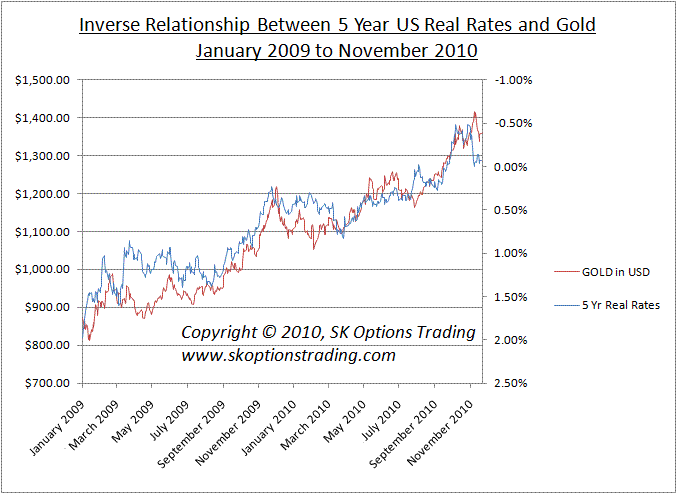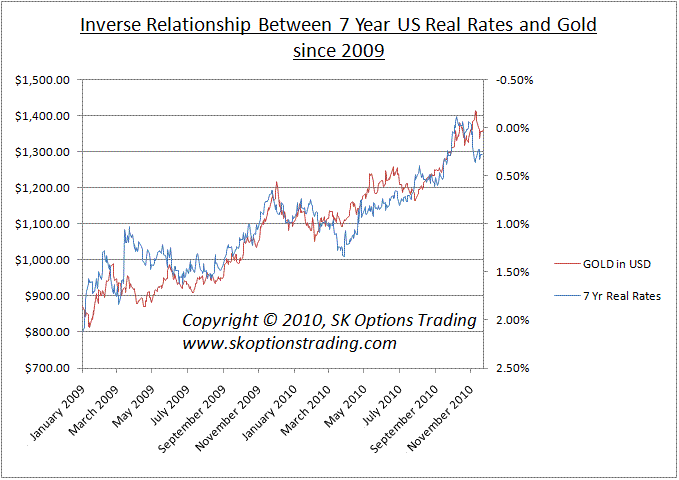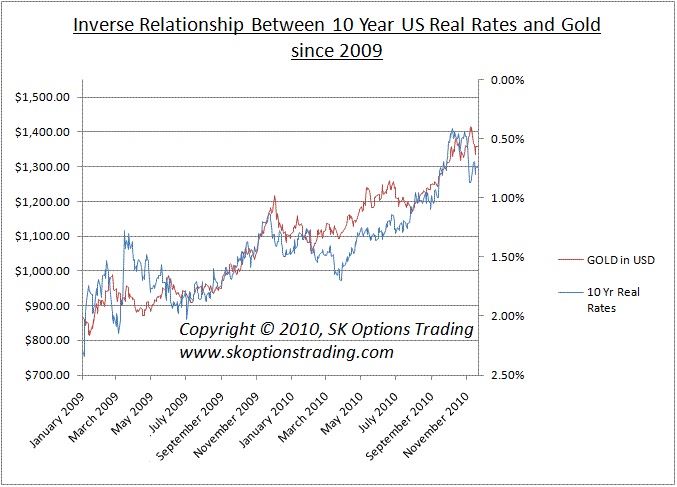The Gold Price Key Relationship With Real US Interest Rates
Commodities / Gold and Silver 2010 Dec 06, 2010 - 04:32 AM GMTBy: Bob_Kirtley
 Gold investors tend to focus overwhelmingly on the relationship between the US dollar and gold, citing that a lower dollar leads to higher gold prices in US dollars. Whilst this may be generally true, there is another relationship that does not get as much attention as we believe it deserves, and that is the relationship gold has with US real interest rates. For the first few years of this gold bull market, it was sufficient simply to acknowledge the USD down, therefore gold up dynamic, but now things have changed. Over the past couple of years gold has rallied when the greenback has been making gains, as well as when it was weakening, therefore investors must now take note of the inverse relationship between US real interest rates and gold, which has been observed consistently over the last couple of years.
Gold investors tend to focus overwhelmingly on the relationship between the US dollar and gold, citing that a lower dollar leads to higher gold prices in US dollars. Whilst this may be generally true, there is another relationship that does not get as much attention as we believe it deserves, and that is the relationship gold has with US real interest rates. For the first few years of this gold bull market, it was sufficient simply to acknowledge the USD down, therefore gold up dynamic, but now things have changed. Over the past couple of years gold has rallied when the greenback has been making gains, as well as when it was weakening, therefore investors must now take note of the inverse relationship between US real interest rates and gold, which has been observed consistently over the last couple of years.

The basic fundamentals behind this inverse relationship are that when US monetary policy is looser, real rates fall and therefore investors buy gold for a number of reasons. Firstly, lower real rates could imply higher inflationary expectations in the future therefore gold is bought as a hedge against this possible inflation. Secondly, lower real returns in Treasuries drives investors into risk assets in search of a higher return. This also sends gold higher but it also sends most commodities, risk currencies and equities higher too. Thirdly, lower real returns on Treasuries reduce demand of US dollars, causing the dollar to fall and therefore the gold price to rise in US dollars. Finally, looser monetary policy implies that the economic situation is not as rosy as many would like to believe, so if the Federal Reserve acts by loosening monetary policy and driving down real interest rates then that send a message that the economy is in a bad place therefore investors buy gold as a safe haven asset. There are probably many more reasons for this relationship, but we have just tried to cover the main ones.

Whilst this inverse relationship is not perfect, it does have a distinct theoretical advantage over simply watching the USD versus gold relationship as sometimes both US dollars and gold can be in demand as safe haven assets. For example if there were to be a crisis, such as the recent sovereign debt issues in Europe, money would flow into gold in search of a safe haven, but also into dollars to escape the European issues. Investors would sell European bonds driving their yields higher, and buy US bonds driving their yields lower. Gold would be rising and the US dollar would be rising, negating their usually negative correlation. However US rates would be falling as investors bought treasuries as a safe haven and therefore the inverse relationship between gold and US treasury rates would hold firm.

The theoretical aspects of this may all be well and good, but what really matters to investors and traders such as ourselves is how these theories can be applied in the real world, and how effective they are in producing profitable signals to trade from. So here is a practical example of how we applied and profited from this relationship in the real world. In late August 2010 we noticed that US real rates were falling far more rapidly that gold prices were rising. We also held the view that the Federal Reserve was going to embark on another round of quantitative easing within the next three months, therefore we did not see US real rates rising, given that the Federal Reserve would likely begin buying bonds heavily. From this we inferred that gold prices we set to stage a major rally to a new all time high, so signalled to our subscribers to buy a great deal of out of the money GLD call options to benefit from this rise (more details can be viewed in our full trading records, which is published on our website). We banked profits in percentage terms, ten times higher that the gains made by gold or the HUI gold mining index during that period, and when the market began to price in QE2 and US real rates fell further we bought again and enjoyed a similar return.
We are now of the opinion that US real interest rates are still too low in relation to the current gold price and therefore see the gold price going still higher to $1500. Of course this works both ways, so if US real rates begin rising there would likely be a serious correction in gold. We are monitoring this situation closely and adjusting our position (and that recommended to our subscribers) accordingly, but the main purpose of this article is to draw investor’s attention to this relationship and suggest that it form a pillar of your fundamental analysis with respect to gold. This is not to say other relationships such as the USD and gold are not to be noted, they should be, but in conjunction with US real rates. By pulling all these relationships together one can get a better picture of where the yellow metal is headed and when it is going to move, which ultimately leads to more profitable trading.
As mentioned before, we are of the opinion that gold prices are heading to $1500, so if you would like to take full advantage of this then please visit our website www.skoptionstrading.com to sign up to SK OptionTrader, our premium options trading service that costs just $99. We have closed 55 trades with 53 winners, and an average gain of 45% per trade including the two losing trades. Our model portfolio has an annualised return on investment of 84.35% without reinvestment of profits.
The charts in this article are plotted with the gold price in US dollars on the left axis and inverted US real interest rates on the right axis to show the negative relationship between the two. The US real rates data is taken from the US Treasury Real Yield Curve and are commonly referred to as “Real Constant Maturity Treasury” rates, or R-CMTs. Real yields on Treasury Inflation Protected Securities (TIPS) at “constant maturity” are interpolated by the U.S. Treasury from Treasury’s daily real yield curve. These real market yields are calculated from composites of secondary market quotations obtained by the Federal Reserve Bank of New York. The real yield values are read from the real yield curve at fixed maturities, currently 5, 7, 10, 20, and 30 years. This method provides a real yield for a 10 year maturity, for example, even if no outstanding security has exactly 10 years remaining to maturity. Gold data is taken from the London Bullion Market Association.
To stay updated on our market commentary, which gold stocks we are buying and why, please subscribe to The Gold Prices Newsletter, completely FREE of charge. Simply click here and enter your email address. (Winners of the GoldDrivers Stock Picking Competition 2007)
For those readers who are also interested in the silver bull market that is currently unfolding, you may want to subscribe to our Free Silver Prices Newsletter.
DISCLAIMER : Gold Prices makes no guarantee or warranty on the accuracy or completeness of the data provided on this site. Nothing contained herein is intended or shall be deemed to be investment advice, implied or otherwise. This website represents our views and nothing more than that. Always consult your registered advisor to assist you with your investments. We accept no liability for any loss arising from the use of the data contained on this website. We may or may not hold a position in these securities at any given time and reserve the right to buy and sell as we think fit. Bob Kirtley Archive |
© 2005-2022 http://www.MarketOracle.co.uk - The Market Oracle is a FREE Daily Financial Markets Analysis & Forecasting online publication.



